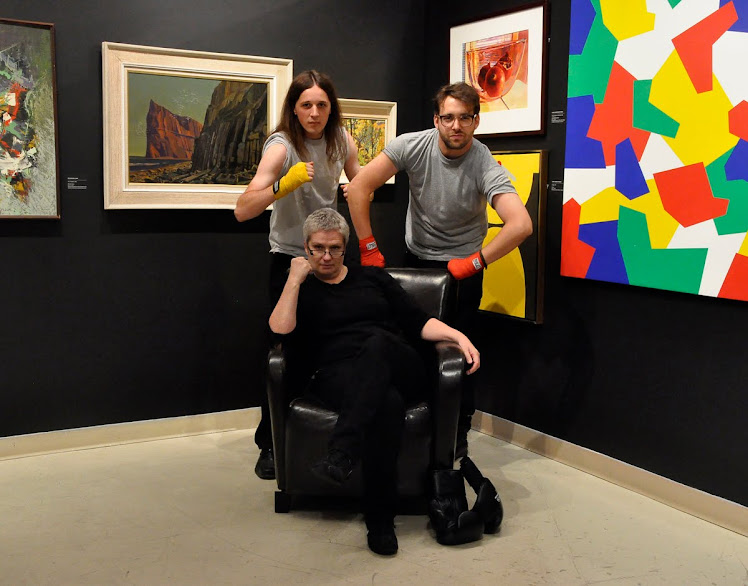
After pulling our respective locations out of the tin, we all went to the vault together - passing Devin, our summer student on the way. Without a doubt there was a completely different mood. Today we were restricted not only by the limits of our respective rack or map drawer, but also by the physical space remaining in the gallery. Our choices today were informed not just by our own likes, dislikes, and personal considerations of the space and how the pieces were relating to one another, but today - we had to pull it together and work as a team. Today discussion happened in the process of selecting as we wanted to understand each others options and collaborate on this, our last choice.

I pulled Map Drawer #8 which contained numerous prints by a number of different artists including David Blackwood, Ronald Bloore, Jessie Oonark and Brian Fisher. While the Fisher was amazing and the Bloore interesting, there was no question that the Oonark would be the strongest choice for the exhibition. Darryn gives some information about Jessie Oonark in his Day 2 posting, so I won't repeat those details here.
Oonark's father was a shaman and, as in most of Oonark's work, powerful inuit myths are thoughtfully recorded. In The World of Sun and Moon, 1976, as in much of her prints and fabric pieces, a geometrically strong, graphic sense informs her work. Using bold, primary shapes and colors, the repetative circular motif stabalizes the eye, allowing the viewer to navigate the central narrative.

I pulled Map Drawer #8 which contained numerous prints by a number of different artists including David Blackwood, Ronald Bloore, Jessie Oonark and Brian Fisher. While the Fisher was amazing and the Bloore interesting, there was no question that the Oonark would be the strongest choice for the exhibition. Darryn gives some information about Jessie Oonark in his Day 2 posting, so I won't repeat those details here.
Oonark's father was a shaman and, as in most of Oonark's work, powerful inuit myths are thoughtfully recorded. In The World of Sun and Moon, 1976, as in much of her prints and fabric pieces, a geometrically strong, graphic sense informs her work. Using bold, primary shapes and colors, the repetative circular motif stabalizes the eye, allowing the viewer to navigate the central narrative.
 Wait until you see this piece in real life! Check out the exhibition in person at the opening reception tomorrow night, Friday August 6 from 6:00 - 9:00 pm. The exhibition will be up until August21.
Wait until you see this piece in real life! Check out the exhibition in person at the opening reception tomorrow night, Friday August 6 from 6:00 - 9:00 pm. The exhibition will be up until August21.++++++++++++++++++++++++++++++++++++++++++++++++++++
About Jessie Oonark, taken from Spirit Wrestler Gallery at http://www.spiritwrestler.com/catalog/index.php?artists_id=88

Jessie Oonark was born in the area of northern Canada known as the Barren Lands, north and west of the present-day village of Baker Lake, Northwest Territories, where she settled in the late 1950s. Her childhood and young adulthood were spent in the traditional pursuits of an Inuit woman: dressing caribou and sealskins, and making parkas and other items of traditional clothing.
Oonark began her career as a graphic artist in 1959, when a Canadian biologist working in Baker Lake gave her art supplies. Her talent was immediately recognized, and she was soon making drawings for sale. A selection of Oonark's drawings were sent from Baker Lake to Cape Dorset, the only Inuit settlement issuing prints at the time.... She was the only outsider ever included in the Cape Dorset print program.
Oonark was a major force in the development of the graphic arts program at Baker Lake in the 1960s and 1970s. Her singular talent was rewarded by an art advisor at Baker Lake who gave Oonark her own studio and a small salary to allow her the freedom of full-time artistic creativity.

No comments:
Post a Comment